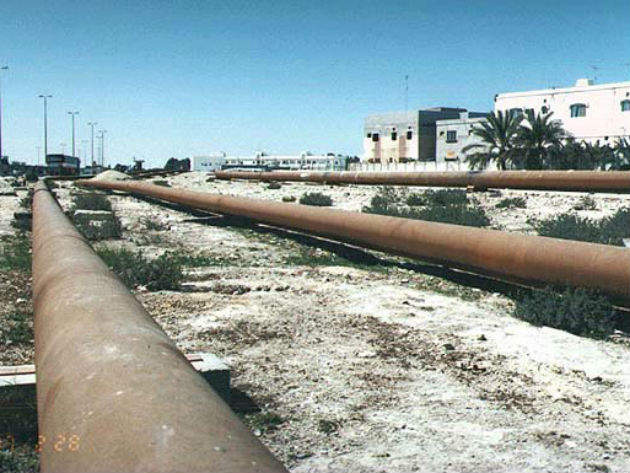
In early 2004, Bahrain Petroleum Company (BAPCO) completed major upgrades to the production capacity and infrastructure of its refinery (the only one in Bahrain). The refinery first opened in 1936 with an initial production of 10,000bpdand has undergone many upgrades including major projects in the early 2000s until its production reached around 250,000bpd.
In 2004-05 BAPCO commissioned a series of projects designed to completely modernise diesel production at the refinery and to bring its diesel products fully into compliance with strict new emissions regulations.
The project was expected to increase the production of a high quality low-sulphur diesel to meet the strict European and US environmental regulations, pursuant to a company policy of expanding diesel oil exports into European markets and emphasising light oil products. The goal was to reduce sulphur concentrations to 0.001% from an average of 0.7% on completion of the project.
BAPCO refinery
The BAPCO refinery has five crude distillation units. The units upgraded comprised a mild hydrocracker, a catalytic reformer, a distillate hydrotreater and a visbreaker.
The refinery configuration is geared for high middle distillate yield operation. The crude oil supply is still fed from the Bahrain field (just over 16%) and Saudi Arabia by a 54km undersea and overland pipeline.
BAPCO’s wharf facility has seven berths and can accommodate transportships of up to 70,000t. More than 700 ships are loaded annually to export petroleum products. Over 95% of BAPCO production is exported to Asia, Japan, Africa and GCC states, and the European and US markets. The company has storage facilities for 14 million barrels of refined products.
Hydrocracker units and other projects
The Japanese oil engineering company JGC Corporation was awarded the construction contract for a new hydrocracker unit with a capacity of 100,000bpd for the production of low sulphur diesel. Construction began in March 2005 and the project was commissioned as scheduled in 2007.
An official inauguration ceremony for the low sulphur diesel production (LSDP) was held in December 2007.
JGC provided design, procurement, construction management and commissioning assistance services. The contract was worth an estimated $725m. JGC were well acquainted with the refinery having conducted four previous modernisation and construction projects there.
JGC undertook the construction of the facilities including the hydrocracking unit, a hydrogen production unit, two sulphur recovery units and off-site utilities, as well as increasing processing capacity of the existing mild hydrocracking unit to 70,000bpd from 54,000bpd and revamping it to an ultra-deep desulphurisation unit. This allowed the achievement of a reduction in sulphur levels in the diesel product down to below 10ppm.
Refinery gas desuplphurisation unit
The construction of a new refinery gas desulphurisation unit with a capacity of 45,000bpd was also planned as part of the project. The engineering, procurement and construction (EPC) contract was awarded to Foster Wheeler and the project was commissioned in January 2009.
The project included the installation of several new grassroots process plants, including a 220t per day sulphur recovery unit, tail gas treating unit, two sour water stripping units, a olefinic gas treatment unit and low flow-off gas streams treatment. The unit reduces hydrogen sulphide (H2S) and ammonia (NH3) content in sour water processed at the refinery to less than 1ppm and 10ppm, respectively.
The first exports from the unit took place in May 2009. The refinery gas desulphurisation unit was officially inaugurated on 27 May 2010. With the completion of the low-sulphur diesel project, BAPCO has the flexibility to produce gasoil, kerosene and liquefied petroleum gas from their sole refinery unit.
Finance
BAPCO raised finance of over $1.233bn for the projects from a series of arrangements with various banks. In March 2005, it signed deals in a package including $370m from the commercial facility, $330m from the Islamic lease facility and $311m of tranche guaranteed by Japan Bank for International Cooperation (JBIC) and Nippon Export Credit Agency.
Additional banks involved in the financing include BNP Paribas, HSBC Bank, Mizho Bank, Arab Banking Corporation,Gulf International Bank, National Bank of Bahrain, Kuwait Finance House, Dubai Islamic Bank and Arab Petroleum Investment Corporation.
The financing was based on a commodity structured scheme that relied on BAPCO’s corporate strength and strong sovereign support. The return on investment from these modernisation and construction projects is expected to be at least 20-24%.
The refining industry is not usually very lucrative. As oil prices change refinery margins may become negative due to the relatively lower product prices compared with crude oil. The economics of the refining industry often dictate that it is more cost effective to upgrade an existing refinery rather than construct a new one from scratch.
In June 2008 BAPCO established a joint venture with Finland’s Neste Oil Corporation to build a high-quality lubricant base oils plant in Bahrain. The plant commenced production in October 2011, and is one of the largest of its kind in the world with an annual capacity of 400,000t of very high viscosity index (VHVI). Feedstock for the new base oil facility is provided by BAPCO’s hydrocracker unit.

